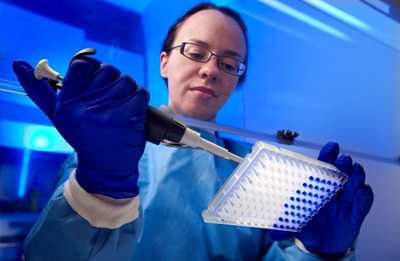AMD Project: Finding the Needle in the Haystack
Using Metagenomics to Diagnose Infections and Control Disease Outbreaks

Using metagenomics, researchers can sequence everything in a patient’s sample and amplify the pathogens without the need to isolate and grow them first.
As CDC faces the challenge posed by emerging infectious diseases, days or weeks spent finding the cause of a cluster of new illnesses could mean the difference between containing a small outbreak or seeing a few cases erupt into a full blown epidemic. Compounding this challenge, new molecular tests have the potential to eliminate the need to isolate and grow pathogens from patient samples (e.g., blood, stool, urine, etc.). By decreasing the isolates shared among public health partners, these new tests can hinder disease tracking. Fortunately, CDC is also investigating new diagnostic tools.
Metagenomics is one of the promising methods CDC is using to detect and track infectious agents. Metagenomics allows sequencing of everything in a patient sample, including normal cells. Then scientists use powerful computer programs to identify any sequences we wouldn’t expect to see in that type of sample. This way, there will likely come a day when we can pick out the infectious pathogen in the midst of sample and see all of its genetic characteristics, such as whether it is resistant to antimicrobials, in one step without first identifying, extracting, and growing it in a culture, which will save time in the diagnostic process. Because this method facilitates sequencing all unique DNA in a sample, metagenomics has the potential to speed up identification and characterization of unsuspected pathogens or even pathogens that have never before been encountered.
Through this project, CDC aims to develop methods to rapidly characterize pathogens without the need for culture. At the same time, researchers will explore and seek to understand the greater role of the whole microbiome in healthy and diseased individuals.
2017 Project Update
In the project’s first three years, researchers began developing tools and methods that will selectively increase a pathogen’s genetic material in clinical samples. This will help investigators better distinguish pathogen genes from human and other genes in the sample. So far, CDC has evaluated and demonstrated methods to selectively increase levels of Shiga toxin-producing E. coli, tuberculosis, and influenza in clinical samples. These methods will enable scientists to uncover the characteristics of pathogens up to 30 days sooner than some older methods. Researches are also evaluating ways to find pathogens in small or poor quality clinical samples. Results from these studies are providing the basis for analyzing samples from real world outbreaks and unknown samples from patients with symptoms of infectious diseases. CDC’s laboratories continue to collaborate on innovative methods to improve capability and capacity to apply metagenomics for solving public health challenges.
- Page last reviewed: March 21, 2017
- Page last updated: March 13, 2017
- Content source:


 ShareCompartir
ShareCompartir